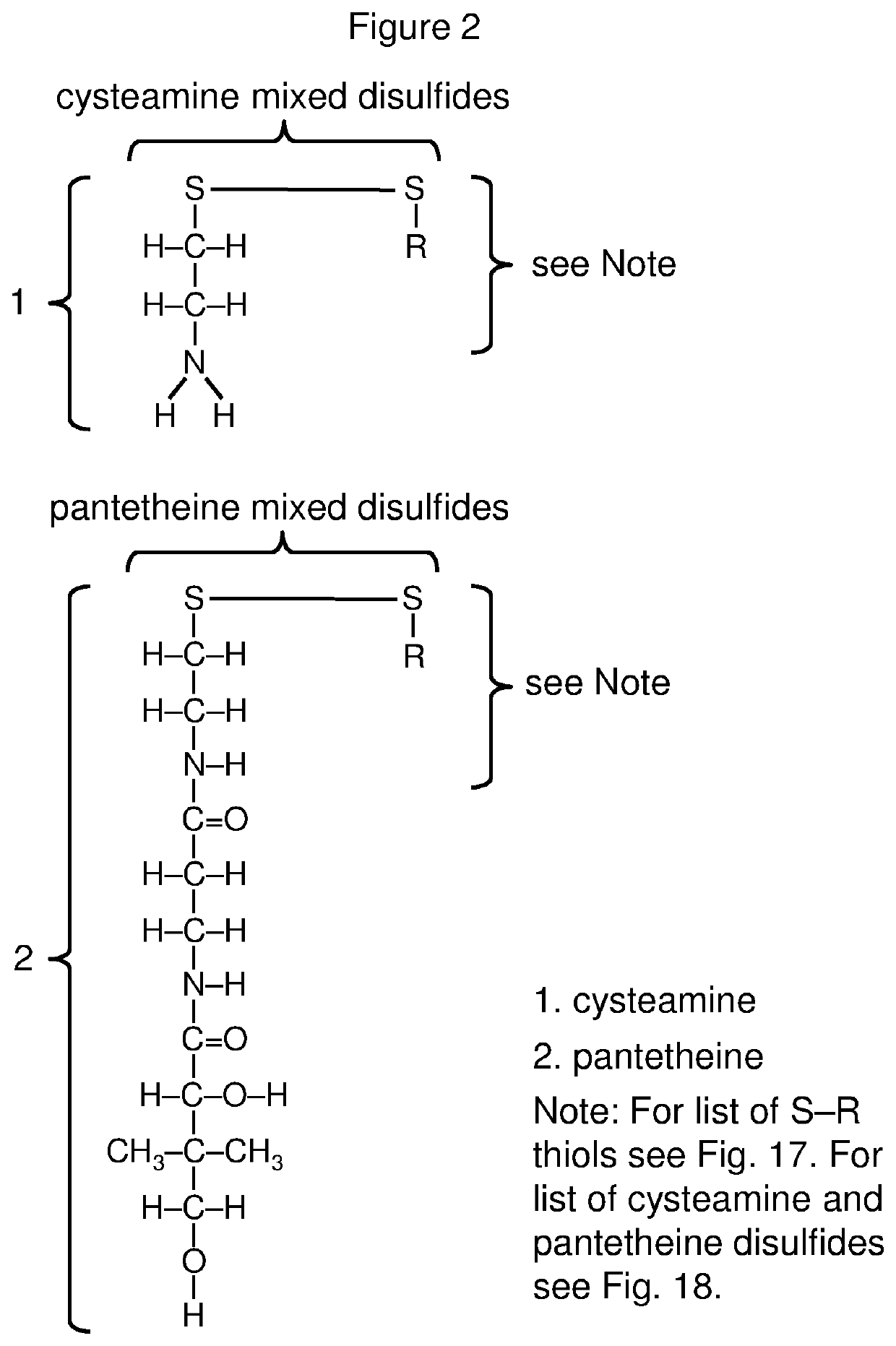Compositions for controlled release of cysteamine and systemic treatment of cysteamine sensitive disorders
a cysteamine and controlled release technology, applied in drug compositions, dispersed delivery, metabolic disorders, etc., can solve the problems of affecting the clinical development of a large number of patients, affecting the effect of cysteamine release, and forming crystals that damage cells, so as to prolong the half life of cysteamine, increase the absorption of cysteamine, and enhance the in vivo chemical and enzymatic reactions
- Summary
- Abstract
- Description
- Claims
- Application Information
AI Technical Summary
Benefits of technology
Problems solved by technology
Method used
Image
Examples
example 1
Synthesis of Mixed Disulfides
[0632]Versatile methods for efficient synthesis of mixed disulfides have been described by several research groups (see reviews by Witt et al. Langmuir 23:2318 (2007); Musiejuk et al. Org. Prep. and Proc. 47.2:95 (2015)), including methods specific to cysteine and cysteine analogs (e.g., Szymelfejnik et al. Synthesis 22:3528 (2007); Gormer et al. J. Org. Chem. 75.5:1811 (2010)). Recent improvements, have been reported, for example based on the use of 2,3-dichloro-5,6-dicyanobenzoquinone (DDQ) to facilitate thiol-disulfide exchange (Musiejuk et al. RSC Advances 5.40:31347 (2015)).
[0633]These methods allow for preferential synthesis of the mixed disulfide (vs. the two homodimeric disulfides) when combining two different thiols. In the present example the thiols cysteamine and pantetheine are coupled using the procedure described by Antoniow et al., Synthesis 3:363 (2007). Other pairs of thiols can also be selectively coupled using variants of this procedur...
example 2
Synthesis of Mixed Disulfides Containing Cysteine or Cysteine Analogs
[0646]Among the thiols useful for producing mixed disulfide cysteamine precursors are cysteine, cysteine ethyl ester, cysteine methyl ester, N-acetylcysteine, N-acetylcysteine ethyl ester, N-acetylcysteine amide and homocysteine, as well as cysteine containing compounds including cysteinylglycine, gamma glutamylcysteine, gamma glutamylcysteine ethyl ester, as well as glutathione (which is a tripeptide of glycine, L-cysteine, and L-glutamate, with L-glutamate having an isopeptide bond with the amino moiety of L-cysteine) and glutathione derivatives.
[0647]A useful protocol for coupling the foregoing and other cysteine derivatives or cysteine containing compounds to cysteamine, N-acetylcysteamine, pantetheine, 4-phosphopantetheine, dephospho-coenzyme A, coenzyme A or suitable analogs or derivatives of those compounds is described in Szymelfejnik et al., Synthesis 22:3528 (2007).
[0648]This method exploits the selective...
example 3
on of Pantetheine
[0661]Nine hundred and fifty (950) parts by weight pantetheine hydrochloride (C11H23N2O4SCl), six hundred and forty (640) parts by weight distilled water, and two thousand (2000) parts by weight food grade microcrystalline cellulose are thoroughly blended at room temperature. The final powdery mixture is used for filling standard, two-piece hard gelatin capsules with 600 milligrams per capsule.
PUM
| Property | Measurement | Unit |
|---|---|---|
| pH | aaaaa | aaaaa |
| pH | aaaaa | aaaaa |
| pH | aaaaa | aaaaa |
Abstract
Description
Claims
Application Information
 Login to View More
Login to View More - R&D
- Intellectual Property
- Life Sciences
- Materials
- Tech Scout
- Unparalleled Data Quality
- Higher Quality Content
- 60% Fewer Hallucinations
Browse by: Latest US Patents, China's latest patents, Technical Efficacy Thesaurus, Application Domain, Technology Topic, Popular Technical Reports.
© 2025 PatSnap. All rights reserved.Legal|Privacy policy|Modern Slavery Act Transparency Statement|Sitemap|About US| Contact US: help@patsnap.com



